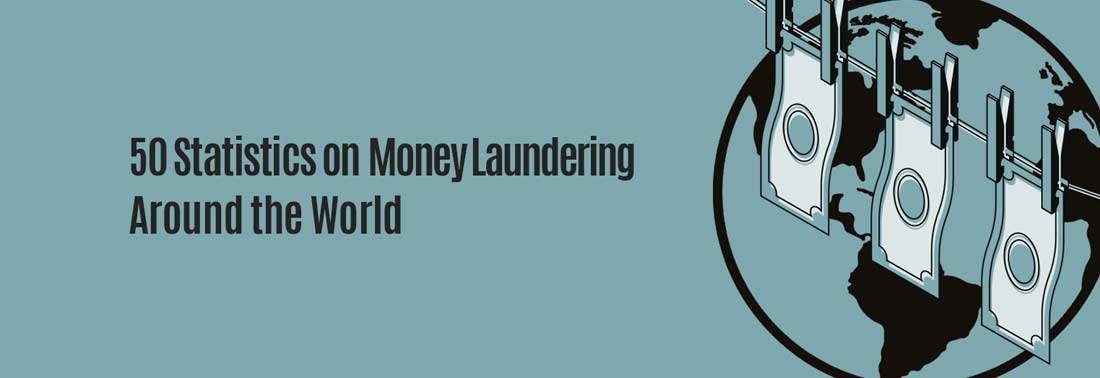Money laundering is known for making financial organizations fight tooth and nail for its permanent destruction. It has become a universal concern for administrative organizations and associations like the Financial Action Task Force (FATF), Financial Conduct Authority (FCA) and Financial Transactions and Reports Analysis Centre of Canada (FINTRAC).
Financial organizations have succeeded in their fight against money laundering by creating more stringent Anti-Money Laundering (AML) laws and regulations to prevent theft. AML laws introduced a variety of regulations like identity verification and background checks, which have proven to be a viable solution against fraud prevention. AML guidelines progressively advance while money laundering rates continue to decrease globally.
However, there is no denying the fact that money laundering persists and those associated with it are active. While AML guidelines persist in their fight against this international issue, money laundering cases continuously appear around the world. Below we have listed fifty shocking statistics showing the impact money laundering has had on a global scale.

- According to the United Nations Office on Drugs and Crime (UNODC), the assessed measure of laundered cash in one year is around $800 billion, which is 5% of worldwide GDP.
- Switzerland published 160 money laundering reports in 1989, with a monetary worth of 330 million Swiss francs- approximating $210 million.
- Authorities found Ferdinand Marcos hid almost $500 million in Swiss bank accounts.
- The GDP of Switzerland is $191,000,000,000 – about one-eighth of money laundered annually.
- Dow Jones published that 1989 GDP had a score of 5% for money laundering, ranging between $1 and 3 trillion.
- In Belgium, between December 1993 and June 1998, 1416 cases of money laundering were reported with a worth of $3.92 billion. Similarly, in 1997, there were 476 reports recorded with a worth of $1.1 billion.
- A 1996 report published by Chulalongkorn University in Bangkok stated that a figure equivalent to 15% of the nation’s GDP, which is $28.5 billion, was illicitly laundered as cash.
- The assessed GDP of the United States in 1998 was $8.511 trillion, which is triple the rate of multiple national economies.
- The Canadian Solicitor General remarked that in 1998 the illegal assets created and washed in Canada annually were somewhere between $5 and $17 billion. This provides a stark contrast as Canada is one of the largest countries to follow and implant AML regulations against monetary fraud.
- In 1998, the Swiss Finance Ministry affirmed that the nation was involved in $500 billion of money laundering every year.
- The Republic of Ireland assesses that in 1998, $126 million were laundered throughout the country.
- In 1999, a congressional hearing was informed that almost $48 billion were produced by illegal pharmaceutical deals.
- It is assessed that two-hundred million pharmaceutical clients intake almost $400 billion in laundered cash.
- In February 2000 General Motors turned over $161,315,000,000, which is roughly a tenth of money laundered every year.
- For a frame of reference, and to understand the gravity of this situation, the annual GDP of $1.5 trillion laundered money is $1,500,000,000,000.
- In 2003, the National Instant Criminal Background Check System (NCIS) expressed that criminal activity will continue and the sum that is illegally laundered is obscure. Customs specialists reported that the yearly scale of financial crime in the UK was between £19 billion and £48 billion, with £25 billion being the gross sum of money laundered every year.
- In 2008, banks reportedly paid up to $321 billion in fines for not agreeing with the administrative norms of money laundering regulations, cyber financial fraud prevention and market control.
- In 2009, worldwide AML guidelines were only 0.2%, indicated by the UN and US State Department.
- As reported by authorities, in 2009 money laundering accounted for 3.6% of worldwide GDP with $1.6 trillion washed, as indicated by the UNODC.
- FATF reportedly blocked $3.1 billion worth of laundered cash in 2009- of which more than 80% was seized in North America.
- In 2014, reported worldwide spend on AML regulation-related fines was $10 billion.
- From 2016-17, one hundred sixty-one cases were documented for money laundering and illegal financial resources under PMLA.
- The value estimated for the Fraud Detection and Prevention (FDP) market was assessed to be worth $19.5 billion in 2017.
- In the UK, from 2017 to 2019, the legal fine for involvement in money laundering and financial fraud was £241,233,671.
- Starting in 2018 India had around 884 organizations reportedly on high alert for money laundering and illegal financial resources worth INR 50 billion. They are currently being tested under the Prevention of Money Laundering Act (PMLA 2002).
- In 2018, India was considered compliant for only four out of forty FATF suggestions.
- As indicated by the Public Authority of India, around $18 billion is lost through illegal money laundering every year, which makes India a big target for international money laundering.
- The number of illegal money laundering cases brought under the steady gaze of Romanian courts has remained moderately stable, ever since the years 2015 and 2019. The latest cases were reported in 2018 when the quantity of money laundering cases expanded by about 14.9 percent contrasted with 2017.
- In 2018, the reported count of global laundered cash washed every year was two to five percent of worldwide GDP, meaning $800 billion – $2 trillion.
- Florida International University was positioned in 9,500 Non-Banking Financial Companies out of an expected 11,500 enrolled, as a potential money laundering association in 2018.
- In 2019, banks paid more than $6.2 billion in AML fines around the world.
- In 2019, Bolivia became the tenth country with the highest potential for money laundering in Latin America with a money laundering index score of 6.01.
- Brazil became the nineteenth country with the least money laundering cases in 2019.
- For the last 2 years, Chile has had a laundering index of 4.16, making it one of the countries with the lowest laundering indexes.
- In 2019, Colombia was positioned 10th place for illegally money laundering in Latin America with a criminal index of 5.83.
- Starting in 2020, the US was compliant for only twenty-two out of forty FATF suggestions.
- Haiti became the largest Caribbean country in 2020 for money laundering instances in Latin America, with a money laundering score of 8.15 according to FATF.
- About half of cases reporting money laundering in Latin America show that banks were involved.
- In 2020, the Cayman Islands had an index score of 7.46 for money laundering. In the same year, Chile became the lowest ranking country with a score of 3.82.
- According to the Prudential Regulation Authority (PRA), there were more than 200,000 cases of money laundering reported in the UK annually.
- Iran remains at the highest point of the Anti-Money Laundering (AML) hazard file with a money laundering index score of 8.6. Afghanistan comes next with a score of 8.38, while Guinea-Bissau is third with a score of 8.35.
- Money laundering takes up about 1.2% of the European Union’s (EU) entire GDP.
- Executing KYC compliance generally costs banks around $62 million, though it assures low money laundering and financial fraud potential.
- The underground market for Peso trade in Colombia is assessed to legally launder $6 billion for every year in pharmaceutical cartels.
- The previous government official of the Congo, Joseph Mobutu, has confessed to financial fraud by having moved up to $5,000 million from his country.
- Russia has illegally laundered almost $15 billion through fake or paper bank accounts
- It has been reported by legal financial authorities that every year $15 billion streams out of Russia through money laundering, adding it to the list of countries with a high money laundering rate.
- The growth and success of anti-money laundering is proven by the growth of its program market. It is estimated that in 2023, the income of international anti-money laundering software programming will add up to about $1.77 billion.
- Mexican pharmaceutical cartels, presently more impressive than their counterparts in Colombia, are reported by authorities to produce illegal financial resources of more than $9 billion every year, which puts up roughly 5% of Mexico’s GDP.
- In Indonesia, one authority expressed that $500,000 is being money laundered consistently between West Africans and Southeast Asians utilizing West African Couriers.
Key Takeaway
For decades now, money laundering has been a major worldwide issue and will continue to rise if laws and regulations are not in place to combat it. According to the United Nations Office on Drugs and Crime (UNODC), the assessed measure of laundered cash in one year is around $800 billion, which takes up 5% of worldwide GDP.
It has become an obligation for all renowned banks and financial institutions to follow AML regulations set by international financial associations. While organizations and governments are continually searching for better approaches to battle tax crimes and money laundering, anti-money laundering regulations are proving to be the most successful solution.
In order to combat money laundering companies have adopted ever increasingly sophisticated tools similar to IDMERIT’s IDMaml solution.
